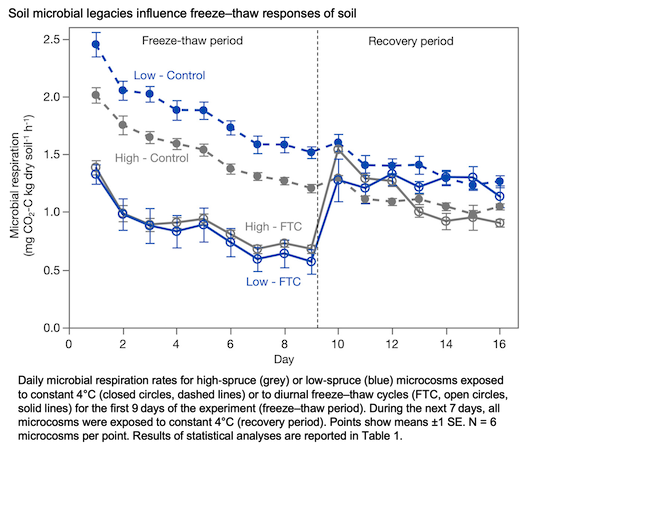
Soil Microbial Legacies Influence Freeze–Thaw Responses of Soil
IGCB Affiliate Professor Aimée Classen was involved in a study led by Melissa Pastore and published in Functional Ecology. Taken together, our data suggest that microbial communities conditioned to less extreme winter soil temperatures may be most vulnerable to rapid changes in freeze–thaw regimes as winters warm, but they also may be able to quickly re- cover if mortality is low.
Abstract: Warmer winters with less snowfall are increasing the frequency of soil freeze–thaw cycles across temperate regions. Soil microbial responses to freeze–thaw cycles vary and some of this variation may be explained by microbial conditioning to prior winter conditions, yet such linkages remain largely unexplored. We investigated how differences in temperature history influenced microbial community composition and activity in response to freeze–thaw cycles.
We collected soil microbial communities that developed under colder (high elevation) and warmer (low elevation) temperature regimes in spruce-fir forests, then added each of these soil microbial communities to a sterile bulk-soil in a laboratory microcosm experiment. The inoculated high-elevation cold and low-elevation warm microcosms were subjected to diurnal freeze–thaw cycles or constant above-freezing temperature for 9 days. Then, all microcosms were subjected to a 7-day above-freezing recovery period.
Overall, we found that the high-elevation cold community had, relative to the low-elevation warm community, a smaller reduction in microbial respiration (CO2 flux) during freeze–thaw cycles. Further, the high-elevation cold community, on average, experienced lower freeze–thaw-induced bacterial mortality than the warm community and may have partly acclimated to freeze–thaw cycles via increased lipid membrane fluidity. Respiration of both microbial communities quickly recovered following the end of the freeze–thaw treatment period and there were no changes in soil extractable carbon or nitrogen.
Our results provide evidence that past soil temperature conditions may influence the responses of soil microbial communities to freeze–thaw cycles. The microbial community that developed under a colder temperature regime was more tolerant of freeze–thaw cycles than the community that developed under a warmer temperature regime, although both communities displayed some level of resilience. Taken together, our data suggest that microbial communities conditioned to less extreme winter soil temperatures may be most vulnerable to rapid changes in freeze–thaw regimes as winters warm, but they also may be able to quickly recover if mortality is low.

